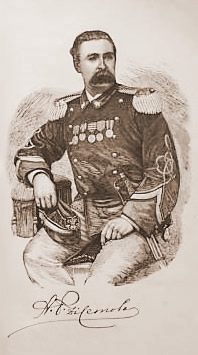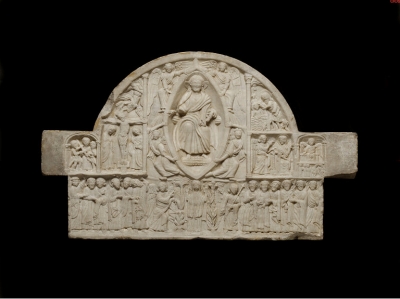To search the RPR site click here
Tympanum from Cyprus
On 27 April 1892 at Sotheby, Wilkinson and Hodge auction house in London, Pitt-Rivers successfully bid for the largest item he ever bought at a sale of the Cesnola-Lawrence collection. He paid an extremely large sum for lot -- £31.10.0. Lot 625 was described as:
Fine large specimens of terra cotta of the several archaic styles which obtain in Cyprus Ancient Christian Tympanum 24 x 41 in elaborately carved designs in Byzantine style. The subjects are the life and passon of our Lord. Found in excavating for a house in Larnaca or Kittuim. Fine white marble. This and the font No 588 being genuine relics from Byzantine churches might be appropriately adapted to ecclesiastical used by a church architect
It was part of the very famous Cesnola-Lawrence collection. This collection had been acquired by Alessandro Palma di Cesnola, and given to his father-in-law, Edwin Henry Lawrence, in lieu of his financial support of Cesnola's collections. To find out more about this collection and the men associated with it, see here.
A tympanum is a 'semi-circular or triangular decorative wall surface over an entrance, bounded by a lintel and arch. It often contains sculpture or other imagery or ornaments. Most architectural styles include this element. In ancient Greek and Roman and in Christian architecture tympana usually contain religious imagery' [wikipedia]
The marble tympanum was entered into the catalogue of Pitt-Rivers' second collection on page 838 of volume 3 [Add.9455vol3_p838 /1]:
Date: 1892 Apr 27
Description of object: Bought at Sotheby’s Sale of Cypriote Antiquities of the late E.H. Lawrence Esq F.S.A. ... Lot 625 [Drawing] Lot 625 Ancient Christian Tympanum 24 x 41 inches elaborately carved designs in Byzantine style. The subjects are the Life and Passion of our Lord. Found in excavating for a house at Larnaca or Kittium. Fine white marble
Price: £31.10
Deposited at: Museum
Removed to:
Added: Room VII case 75 [in red]
As you can see from the above catalogue entry, the object was delivered and displayed at Farnham Museum, Pitt-Rivers' private museum in Dorset.
As with most items from Pitt-Rivers' second collection, the tympanum would have stayed at the Museum until the middle of the twentieth century when it was one of the objects that was sold on the open art market. The purchaser was the Victoria and Albert Museum and the artefact now forms part of that museum's collections. [Museum number A.2-1982] It is ironic that this object has ended up in this collection as, of course, Pitt-Rivers' founding collection had been on display there for over 7 years during the 1870s and 1880s.
The object is now on display in the Medieval and Renaissance Galleries, Room 8 case WN.
The Victoria and Albert Museum describes this object as 'The Larnaca Tympanum' and says:
This small tympanum was excavated in Larnaka, Cyprus, shortly before 1882 by the noted archaeologist Cesnola. It must have stood above one of the doors into a church. However, it is far too small to have been above any of the Western doors. Scenes of this sort, combining narrative images with representations of Christ enthroned in heaven were common choices for portal imagery. The person entering the church was encouraged to think about the events of Christ's life, but also about his ever-present nature.
It is likely that the artists who carved this piece had trained in Tuscany, and they were also clearly aware of Byzantine artistic conventions.
This piece emphasises that artistic styles did not change overnight - they could co-exist in the same period. The composition of this tympanum owes something to gothic examples. But the figure style, in particular the heads of the Apostles, and the awkwardly twisting postures of the angel figures, show the continuing vitality of romanesque conventions.
Tympanum, marble, with a relief of the Ascension. The relief shows the Ascension with the twelve apostles, two archangels and the Virgin orans; other scenes show the Carrying of the Cross, the Crucifixion, the Baptism of Christ, the Annunciation, and the Maries at the Sepulchre. Height: 62.3 cm, Width: 104.7 cm including wings, Depth: 8 cm
It is not known which church this piece is from. It was first published by the archaeologist Cesnola in 1882. It came to London as part of the Lawrence Collection of Cypriot antiquities, and was sold on to the Pitt Rivers Collection in Farnham.
The Museum believes that the object was created between 1210 and 1230 AD. The tympanum was displayed at the Saladin und die Kreuzfahrer exhibition at the Reiss-Engelhorn Museum, Mannheim from 15 October 2005 to 20 January 2006.
Not much is known about the object, how it was found, and why Cesnola (who was usually more concerned with acquiring older Cypriote antiquities) acquired it or why it was not sold by Lawrence until after his death (though he sold most of the remainder of his Cesnola collection before his death in a series of sales that are described here).
Adrian Boas says of this object:
Some of the finest non-figurative sculpture of the Latin East is found in Gothic churches and other buildings in Cyprus, but virtually no figurative sculpture of the quality found in the kingdom of Jerusalem has yet come to light there. From Larnaca comes a bas-relief, now in the Pitt-Rivers Museum, Farnham, Dorset, [sic] which Enlart suggests may have originated in Famagusta or Paphas (Enlart 1987: 43]. It decorated either a doorway or an altar. The tympanum can be divided horizontally into two sections, the upper semicircular part containing at its centre the figure of Christ in an elliptical mandorla supported by four angels. On either side are smaller panels containing various scenes. These include, on the right, the Crucifixion and the Carrying of the Cross, and on the left the Visitation, the Baptism and a scene with an enthroned angel above two donors and two fighting soldiers. The lower rectangular register of the typanum contains the Annunciation with six apostles on either side of the Virgin Mary and, for the sake of symmetry, two representations of Gabriel. This work, a fusion of Gothic and Byzantine styles, is, in the words of Enlart, 'clumsy, heavy and incorrect' [Enlart 1987: 320] [Boas, 1999: 193]
Boas seems to have taken the description from Enlart and also says that in Enlart's opinion the work dated from the end of the fourteenth century [1987: 43] though this date has obviously been revised in more recent work. Other work describes the Visitation as the Annunciation, and say one of the scenes show the three Maries and the soldiers at the Tomb of Christ. [Hill, 2010: 1137]
Bibliographic References provided by the Victoria and Albert Museum webpage for this object:
T.S.R. Boase, 'v. The Arts in Cyprus, Ecclesiastical Art' in K.M. Setton (ed.), A History of the Crusades, Madison, 1977, vol. IV, p. 186
A. Palma di Cesnola, Salaminia (Cyprus); The History, Treasures and Antiquities of Salamis in the Island of Cyprus, London, 1882, p.108 and pl. IX
C. Enlart, L'art gothique et de la Renaissance en Chypre, Paris, 1899, vol. 1, pp. 15-16
Camille Enlart. Gothic Art and the Renaissance in Cyprus. London: Trigraph/A. G. Leventis Foundation, 1987
P. Hetherington, 'The Larnaka Tympanum and its origins: a persisting problem from 19th century Cyprus', in Report of the Department of Antiquities, Cyprus, 2000, Nicosia, 2000, pp. 361-378
P. Williamson (ed.), European Sculpture at the Victoria and Albert Museum, London, 1996, p. 49
M. Willis, 'The Larnaca Tympanum' in Kypriakon Spoudon, May 1981, pp. 15-28
See also
Adrian J. Boas 1999 Crusader Archaeology: The material culture of the Latin East Routledge
George Hill, 2010 A History of Cyprus Cambridge University Press
See http://collections.vam.ac.uk/item/O94070/tympanum-the-larnaca-tympanum/
See here for more information about other Cesnola-Lawrence items previously owned by Pitt-Rivers that have entered the open art market.
AP May 2012






